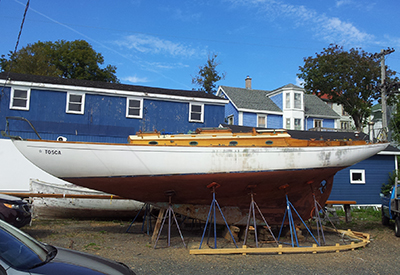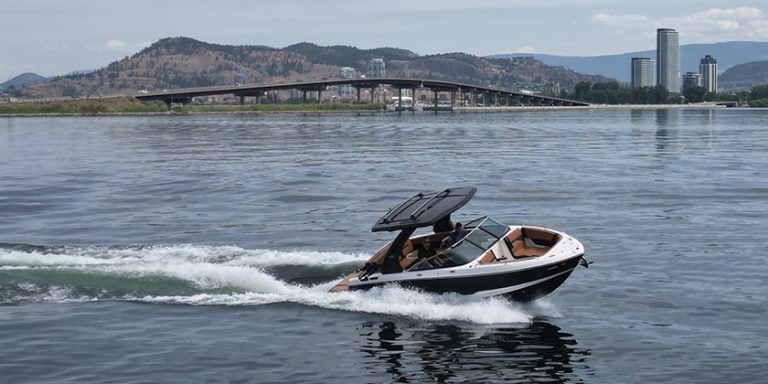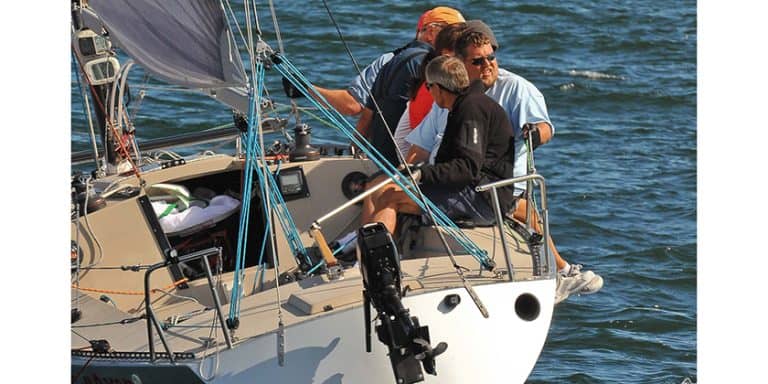Tosca at the Dory Shop

Dec 5, 2018
The crew at the Dory Shop in Lunenburg have an interesting project, something a little outside their usual dory work. Trudi Peterson Inglis has written a detailed and interesting description of the repairs being made to the Concordia Yawl Tosca.
Whoever would have thought a hurricane would bring about the design of one of the world’s most renowned and classic yawls? Certainly not me. It is one of the more surprising – and perhaps lesser known – quirks in the story of the Concordia Yawl.
Waldo Howland, owner of Concordia from 1932 to 1969, lost his family’s Escape – a circa 1890 Norwegian pilot boat – to the Great Hurricane of 1938. Waldo had Concordia Company design something to replace his much-loved boat – he wanted a racing/cruiser daysailer that could handle the choppy seas of Buzzards Bay.
Concordia Inc was established in 1926 by Waldo’s dad, Llewelyn, and named for the Howland family’s whaling vessel. The company started designing frostbite dinghies and eventually moved on to larger 28-foot boats and from there Concordia began to establish itself as a company which produced well-designed, high-quality wooden craft. At Waldo’s request came “design number fourteen”. Nobody knew at the time #14 would become the classic Concordia yawl – one of the most successful racer/cruisers of all time. And perhaps the most famous and beloved production wooden yacht of all time.
Between 1938 and 1966 Concordia Company commissioned 103 Concordia yawls to be constructed. All but the first four were built in Germany, at the shipyard Abeking & Rasmussen; and all but one are with us today – clearly demonstrating the incredible quality of the yawls. Such a close and trusting relationship developed between the two companies, that Abeking & Rasmussen would often produce, and ship completed yawls to Concordia in the USA before payment was made, trusting that Concordia would honour the debt (which, of course, they always did).
Since 1966 Concordia Company has continued to design and build different boats, however none have surpassed the fame of the Concordia Yawl.
In 1959 Concordia Yawl #73 was built and shipped to the USA. Since her first owner, Allen Chamberlin, she has had a few names changes: from Windemere, to Ygerne (A.T. Klotts), to Tynaje (P. Ross) and finally to Tosca in 1977 (R & A Harrison). In 1979 Drs. Gerald & Mary Fitzgerald purchased Tosca and she has remained with them cruising extensively in Newfoundland and Cape Breton ever since.
In 2015 Dr. Gerald Fitzgerald came to Lunenburg to take part in one of our dory building classes. In his spare time, he visited a few different boatyards in and around Lunenburg, but ultimately, he liked the look and the feel of the Dory Shop. A small wooden boat yard with 100 years of experience under their belt. He spoke with his family, and together they decided the Dory Shop would be the place that should look after Tosca. While in remarkably good shape for being a 56-year old wooden boat, the time had come for some tender and somewhat invasive care.
Tosca In Lunenburg
Tosca arrived at our yard from Cape Breton by truck on Thursday 4 August 2016. While we have a fantastic boat repair shed big enough for CONCORDIA and bigger it was blocked by a trailer (soon to be removed). So, we built a nice white Quonset-style hut over the yacht right next to where we build our dories. Working outside year-round in Lunenburg is something that was done once upon a time, on working fishing schooners, but not so good for fine yachts like Tosca that would suffer exposure quickly and terribly in the hot sun, pounding rain and freezing snow. Wooden boats simply cannot sit outside unprotected from Mother Nature, fresh water is their Kryptonite. The shed was built with room enough for a workbench, stairs to take us up to the deck, and all the bits and pieces our gang was going to need.
This yacht is a real beauty – beautifully designed and engineered – the job to be done is big. To make sure nothing was overlooked, our first step was having an independent survey done of the hull, and we turned to John Steele for this – former owner of Covey Island Boatworks, John is a local with many, many years of boatbuilding experience under his belt, and a deep knowledge and understanding of ocean vessels. His thoughts were the same as ours – extensive work was required, but all manageable, and considering her age she was in remarkable shape.
Work Commences
 The first task was to sand the bottom down to bare wood, so we could see what was lying in wait under the paint. From there a plan was put into motion. Where accessible the keelson showed signs of decay or erosion. Not punk or swampy but a bit ‘iron-sick’. This is common when you have an iron/oak connection. Consulting with Brodie McGregor at Concordia Yard in Padanarum confirmed that what we were facing was pretty standard in 60-year-old Concordias. Bear in mind that no boat on earth has ever been designed to last much more than 20-30 years.
The first task was to sand the bottom down to bare wood, so we could see what was lying in wait under the paint. From there a plan was put into motion. Where accessible the keelson showed signs of decay or erosion. Not punk or swampy but a bit ‘iron-sick’. This is common when you have an iron/oak connection. Consulting with Brodie McGregor at Concordia Yard in Padanarum confirmed that what we were facing was pretty standard in 60-year-old Concordias. Bear in mind that no boat on earth has ever been designed to last much more than 20-30 years.
The frames needed attention as well, with several so soft you could push through the existing wood with a finger. So far, all the work has been straightforward, but delicate and time-consuming. From the outset, it appeared the trickiest task of the entire refit, with a few more variables than we would have liked, would be the keel-bolt renewal job. Again, discussions with Brodie McGregor (from Concordia) confirmed our suspicions that it can go hard, or it can go easy but is most likely quite needed at this point. Keel bolt failure, of course, can be catastrophic. If you’re going to do a job like this, you want it to last forever (or as close to forever as we could get) and so the decision was to replace the keel bolts with Monel. The problem was that the existing steel bolts in cast steel keel were fused and thus a lot harder to remove.
The cast steel/iron ballast keel needed to be chipped of rust followed by light sandblasting, brought down to bare steel and coated with epoxy paint to 16mils or so. Barring a grounding leading to a mechanical break in this paint it would stay perfect for almost ever after at that point. This procedure would also reduce to a minimum any threat of electrolysis due to having an iron/steel keel. We are lucky to have ABCO right here in Lunenburg – they were not only able to take care of the sandblasting but removed the keel bolts in a jiffy as well.

Additional Floors
We felt it would be wise to introduce some additional floors to Tosca and connect the new keel bolts to them. These are of bronze and will ride up quite a few strakes to spread the load.
Planks

All planks from the waterline down needed to be replaced, and we wanted to replace them with the same wood type of wood (mahogany) for heritage integrity. We found some beautiful African Mahogany a good match to the original. A slight deviation from the original design, we decided double-plank her. The old planks above the waterline will be rabbeted to allow for a smooth, seamless transition to the new ones.

Keelson
The Keelson is an integral part of the boat as it holds the ballast to the ship and the ship to the keel. The wood needs to be strong, durable, and preferably rot resistant. Another discussion with Brodie at Concordia had a very heavy, single large piece of Angelique delivered to the Dory Shop yard from our friends at Gannon & Benjamin on Martha’s Vineyard. It was a painstaking job indeed for Mike to carve it by hand to fit the hull. Quite a rare piece of sculpture it is when all carved. Angelique is an incredibly hard wood and is so naturally resistant to bugs and rot it requires special clearance (and massive customs delays) before it could be brought into Canada. The incredible denseness of the wood, which was important for the integrity of the keelson, also meant it was very difficult and slow to carve.
Butt Blocks
There was one area near the starboard forward shear where two plank ends were loose and did not hold paint. The butt block behind this point is loose. The inability to make paint stick here may be due to water getting in the butt seam. All other butt blocks were sound on inspection.

A Few Changes To The Original Design:
Why mess with perfection? Well, sometimes things simply can’t be done the old way, due to space constraints or product availability. In addition to the double-planking, we felt it was a good idea to fabricate some small varnished hanging hackmatack knees in the way of the mainmast partners to tie things together as the partners area around the mainmast was a bit light. Being the Dory Shop, we certainly have plenty of hackmatack knees on hand for this.
Another change to the original design is some caulking and putty. The replaced planks, while tight-fitting, need to be caulked and paid with a good sealer instead of tight pressure fit as was done originally. Due to the concave nature of the area we will be working in it is difficult to reproduce the original plank fitting technique and assure watertight integrity.
Tosca still isn’t complete, though we haven’t been working at her 24/7. There are days in winter when it is simply too cold to work; likewise, this summer has been a blistering one and there have been many days when physical work in a plastic encased tent is not where you want to be even with the sides removed for ventilation and besides, it’s summer – time to go sailing! op of Form
Trudi Peterson Inglis
www.doryshop.com
Credits for 6 photos:
Tosca – G. Cairns
Tosca Shed, Tosca at the Dory Shop, Tosca new planking, Tosca Rabitting, Tosca lots of plugs – Dory Shop




























